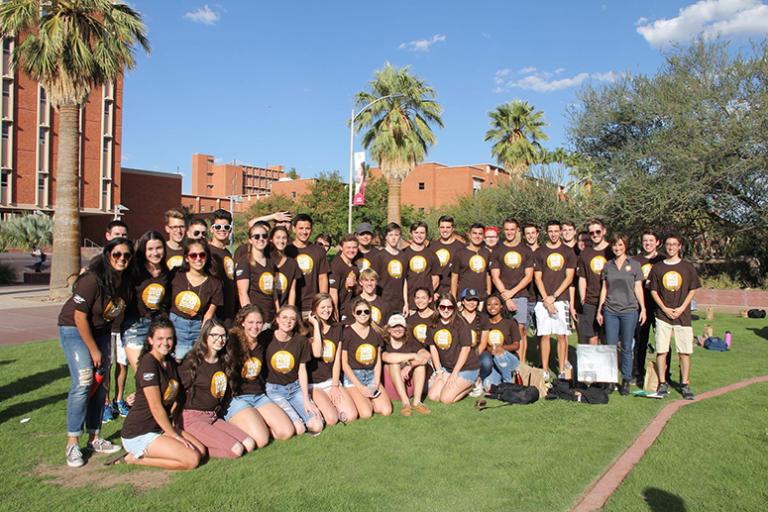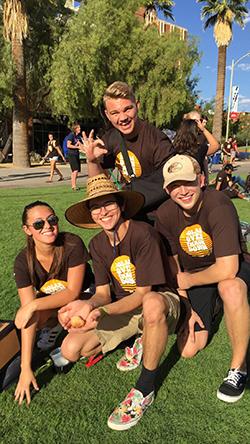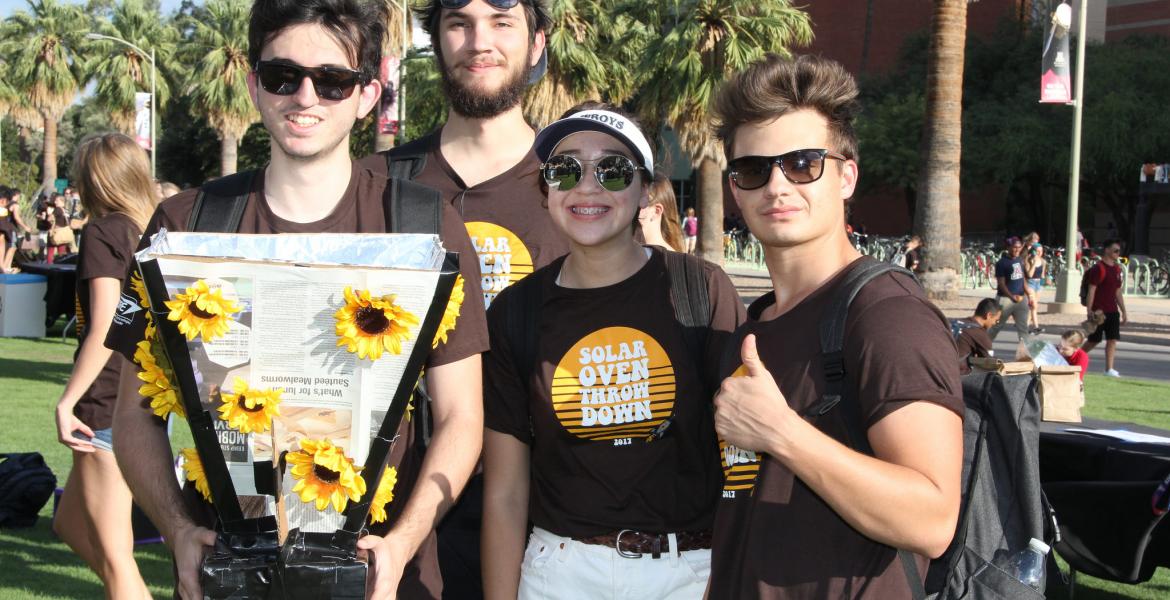Together, Freshmen Stay the Course at 2017 Solar Oven Contest
The clouds started rolling in just as 500 first-year engineering students were setting up their 97 ovens on the UA Mall for the College of Engineering’s 2017 Solar Oven Throw Down on Oct. 11. But facing down challenges is the name of the game at this annual display of science, math and teamwork skills.
Students in all 10 sections of the University of Arizona’s required introductory engineering course spent their first six weeks of college modeling, designing, building and rebuilding solar ovens from scratch. They also were required to make water pasteurization indicators, or WAPIs, small tubes containing a soy-based wax that melts when water, though well below boiling, is safe to drink.
The students’ main objective was not to bake biscuits or even try out their WAPIs, though they did try, but to maximize their performance index -- that is, to best predict the highest temperatures their ovens would reach at the Throw Down, based on thermodynamic models they developed.

This year’s top award went to instructor Kasi Kiehlbaugh’s section, whose teams had the highest average performance index. In other words, on average they came closest to hitting their model predictions. The class average performance index was 40.8; the winning group got a performance index of 154, and their oven reached 154 degrees Celsius.
“The clouds initially caused some concern among the students, but the sun eventually broke through, and everyone was able to enjoy the results of their hard work,” said Kiehlbaugh. “Oven temperatures soared as the clouds cleared, and I saw many proud students exclaiming over their fluffy golden-brown biscuits.”
Students began setting up their ovens for the 50-minute contest at 3 p.m. Ambient temperatures reached 96 degrees Fahrenheit, and many of the ovens generated considerable heat of their own despite the overcast conditions. Still, the clouds did prevent many teams from achieving their predicted temperatures.
“Our max temperature was about 130 degrees Celsius, and our predicted temperature was 160 Celsius,” said Liz Major, who brought previous solar-oven savvy to the contest, having built them at Gila Ridge High School in Yuma, Arizona, for ENGR 102 HS.
“If we’d had good sunlight for a longer period of time, we would have come pretty close because our oven didn't even start getting hot until the end of the Throw Down, when the clouds moved out of the way.”
Major, of the Outnumbered team, could have skipped the semester of ENGR 102 at the UA because she had successfully completed the yearlong high-school version of the course. But she chose to take it again, she said, “to learn more about engineering.”
Even students who got off to a rough start before the contest began ultimately redeemed themselves.
“This has definitely not been smooth sailing,” said Sarah Giroux of the Sunflowers team. “Our prototype oven and Excel model had many errors at first. But through our class’s dissection and help from Dr. Kiehlbaugh, we were able to improve our oven significantly. Our new oven got about 30 degrees hotter, to 140 degrees Celsius, or 284 degrees Fahrenheit -- much closer to our predicted maximum temperature of 284.2 degrees Fahrenheit.”
Students were restricted to using only commonly available materials -- like cardboard, aluminum foil, construction paper, duct tape, Mylar film and newspaper -- and required to design flat reflector surfaces and oven chambers at least 5 centimeters high with a volume of 1,000 cubic centimeters.
Despite the everyday materials, ovens adorned with drawings of sunflowers and pirates and various spray paintings stood apart.
Every oven needed something to measure the angle of the sun’s rays to ensure it was aligned to capture them. For the makeshift sundials, teams affixed pencils, credit cards and PVC piping to their oven boxes; one team strung two pieces of string crosswise over the reflector opening.
Team names spanned the spectrum, too: Shipwr3ck’d, Son of a Biscuit, Bear Down Biscuits, Disco Inferno, Correction Perfection, Ovengers, Sunnyside Up.
Because they had yet to declare specific engineering majors, one team called themselves the Undecideds.
“That’s what I love about this college: We don’t have to declare a major until our sophomore year,” said Sarah Huggins-Hubbard. “It allows us to find what engineering discipline really fits.”

Freshmen in the College of Engineering have been making solar ovens in the introductory course for many years, said Brian Cunningham, course coordinator and lead instructor, but only for the past eight years have class sections come together to compete at the Solar Oven Throw Down.
Student/Faculty Interaction Grants from the UA Office of Student Affairs and Enrollment Management help support the event, which was sponsored for the eighth consecutive year by W.L. Gore & Associates, an international technology company.
Six engineers traveled to Tucson from Gore’s Phoenix and Flagstaff offices to select the winner of the company’s All-in the-Same-Boat Award, which recognizes outstanding teamwork.
The Dean WAPI Goldberg Team -- named for College of Engineering dean Jeff Goldberg and the little life-saving gizmos students had assembled -- won the award.
The teammates, from instructor Ken George’s section, “not only filled in each other’s weaknesses with each other’s strengths, but helped each other grow their weaknesses into strengths,” said Gore engineer Rae Gargione, who received her bachelor’s degree in industrial engineering from the UA in 2012.


